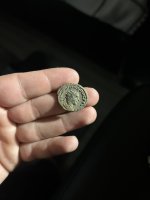Michigan Badger
Gold Member
There is this belief that long time buried copper coins give a stronger signal than fresh buried copper coins.
This is true but some people don't understand what we mean by stronger signal.
I have a friend who has been using the DFX for years and still has not found a single Indian Cent. His problem is he doesn't understand that long time buried copper coins don't sound like fresh buried copper coins.
Copper corrupts after having been buried for 50+ years. The more it corrodes the more it MAY sound like iron to the metal detector and for some reason iron detects a lot deeper than nonferrous metal. Some say the corrosion makes the coin appear larger to the detector but personally I don't buy that theory. Anyway, as ground minerals pack around the coin, this mineral masking affect may cause the coin's signal to increase in volume and it may cause it to sound/read more like an iron washer than a coin.
Many people seeking deep old copper make the mistake of setting their discriminations too high. They set their machines to just accept copper coins fresh buried and all corrupted signals are then ignored. But it may well be the corrupted signals (broken signals) are the old copper coins.
The problem with tone machines is about the time the signal gets down to where the old copper coins are the tone is corrupted due to the signal becoming more iron-like (ferrous). Many make the mistake of listening only for clear high tone coin signals. The deep old smaller copper coins may read/sound more ferrous than nonferrous. As you dig down you will notice the signal greatly improves due to less mineral masking to the coin.
SUM: So the depth and length of time a copper coin has been buried can greatly affect the signal. Long time buried copper coins usually give a louder signal than fresh buried but that louder signal may be mostly an iron signal (mostly iron with a faint high tone mixed in).
Extra Note: Sometimes copper coins buried a long time in very dry climates may sound just like fresh buried copper coins of the same type. But these will usually not detect nearly as deeply as those in moister soils where the coins corrode more.
Hope this helps someone.
Badger
This is true but some people don't understand what we mean by stronger signal.
I have a friend who has been using the DFX for years and still has not found a single Indian Cent. His problem is he doesn't understand that long time buried copper coins don't sound like fresh buried copper coins.
Copper corrupts after having been buried for 50+ years. The more it corrodes the more it MAY sound like iron to the metal detector and for some reason iron detects a lot deeper than nonferrous metal. Some say the corrosion makes the coin appear larger to the detector but personally I don't buy that theory. Anyway, as ground minerals pack around the coin, this mineral masking affect may cause the coin's signal to increase in volume and it may cause it to sound/read more like an iron washer than a coin.
Many people seeking deep old copper make the mistake of setting their discriminations too high. They set their machines to just accept copper coins fresh buried and all corrupted signals are then ignored. But it may well be the corrupted signals (broken signals) are the old copper coins.
The problem with tone machines is about the time the signal gets down to where the old copper coins are the tone is corrupted due to the signal becoming more iron-like (ferrous). Many make the mistake of listening only for clear high tone coin signals. The deep old smaller copper coins may read/sound more ferrous than nonferrous. As you dig down you will notice the signal greatly improves due to less mineral masking to the coin.
SUM: So the depth and length of time a copper coin has been buried can greatly affect the signal. Long time buried copper coins usually give a louder signal than fresh buried but that louder signal may be mostly an iron signal (mostly iron with a faint high tone mixed in).
Extra Note: Sometimes copper coins buried a long time in very dry climates may sound just like fresh buried copper coins of the same type. But these will usually not detect nearly as deeply as those in moister soils where the coins corrode more.
Hope this helps someone.
Badger
Upvote
0






